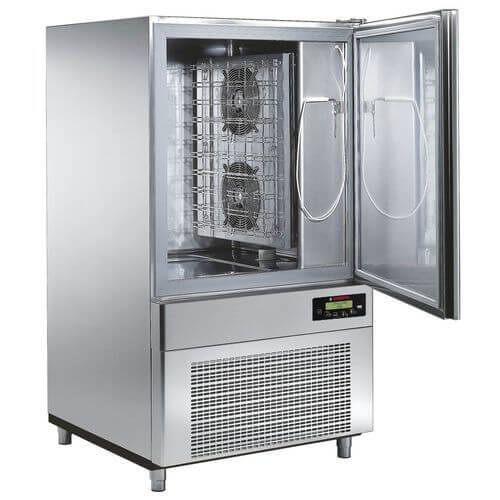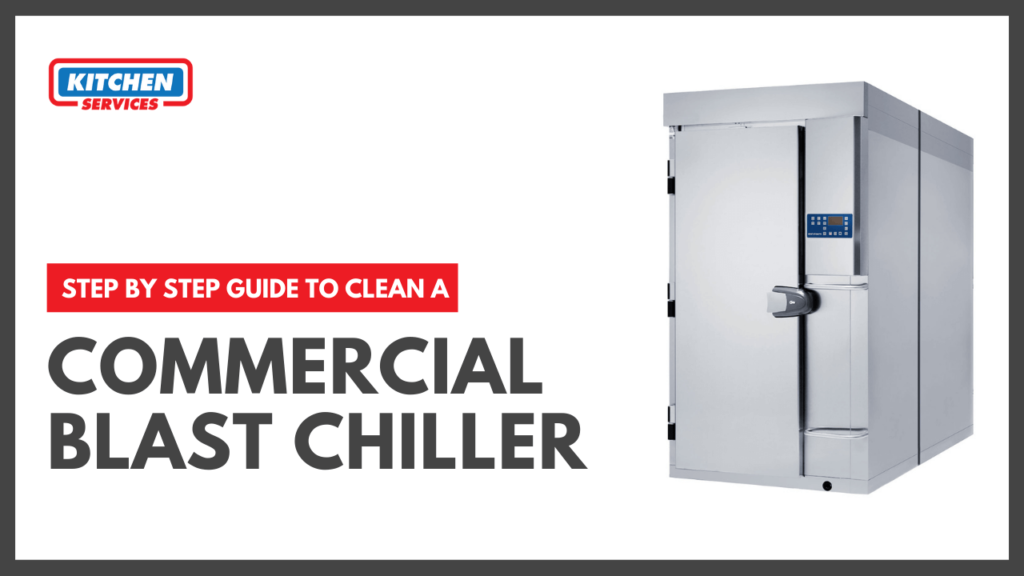As we all are very well aware of the freezers and chillers but here the main topic is about the “commercial blast chiller”, so a blast chiller or freezer that may not sound like other home appliances, but in fact, this product has the ability to be one of the most important parts of your kitchen setup. Your blast freezer has the ability to chill or freeze any of your food a lot quicker as than these ordinary freezers. You will get all the necessary nutrients and vitamins while preventing the growth of bacteria within that food.
Blast freezers usually have many shelves where all your food pans or sheet pans can be stored and chilled at exceptionally low temperatures. In blast chillers, proper temperatures actually mean the difference between maintaining the food quality during the cooling process and possibly creating such kind of environment that is unsafe and that breeds bacteria. Proper maintenance of your blast freezers is very important with the safety reference since temperature stability is key for HACCP reporting.
Maintenance of Commercial Blast Chiller Freezer

Not all blast freezers have the same service life this time period depends on their usage, environment, and the company but most of the blast freezers usually have a service timeline of about 5 and 10 years. Properly certified cleaners take many steps to extend the service life of your blast freezers and to keep these freezers in the best operating condition. You should always turn off your blast freezers when they are not in use because they are not designed on the pattern of normal refrigerators, and they are designed for specific functions only.
Although blast freezers are designed for some specific functions unlike normal freezers, all the maintenance requirements of blast chillers are somehow the same as refrigeration equipment. You still have to clean all the condenser coils; this is a very important step, and it does not only keep the unit chill in the best way, but it is also very important for ideal energy productivity.
- The condenser coils should be cleaned every 30 days, with the help of non-metal brushes to remove all the dust and dirt from these condenser blades. There should be as much airflow as possible.
- Clean condensers by popping off the unit’s front panel on a weekly or monthly basis, depending on usage, environment, and other factors.
- Your blast freezer’s shelves should always be kept clean and there should not be any food particles and spills on them.
- You should always clean the door baskets; you should wash them with water and then wipe them down with a dry cloth in order to provide a tight seal.
- If in any case the hot air and wetness get inside your blast chiller, the unit will have to work a lot harder in order to maintain proper temperature inside it.
- Not just the interior but the exterior of your blast freezers should also be kept clean and wiped down properly with a mixture of mild soap and water after use.
- Other than keeping the inside clean, you should also keep the probes in working order. So that they do not get damaged if closed in a door.
- You should always keep the drain lines clear of condensate water to prevent blockage.
- If you notice any sort of inconsistency in the cooling of your unit, workers should make sure that the condenser is clean. If a dirty condenser is not the issue, then your unit might need to be replaced with the new one.
- In this case, when you realize that the repair and service charges are getting to add up, it may be more convenient and cost-effective to replace your blast chiller with the new one.
- If the blast chiller has unnecessary leakage inside the evaporator or the whole refrigeration system, this may alert you for replacement, but it depends on the unit’s age.
- Because blast chiller evaporators can be pricey to replace, operators should consider retiring units between five and seven years old that leak.
Mistakes to avoid while using Commercial Blast Chiller
There are some mistakes that may contribute to long and productive service life for commercial blast chiller that you may look upon as well, these are.
- The major mistake that operators sometimes make is that they put big sheet pans with the smaller pans on top, this can impede the cooling process and you must avoid it.
- In many restaurants, chefs and cooks try to put plastic on top of the pans. The plastic, on the other hand, can go into the condensers, which affects the airflow.
- You always need to make sure that probes are in good working condition and the wires are not damaged or worn.
Unfortunately, your blast chiller will hardly show signs when its breakdown is nearby. Blast chillers do, however, show some signs they may be near the end of their service lives and will soon require a replacement.
How To Care for Your Walk in Blast freezer

Blast chillers play a vital role in food safety as they stop the chances for harmful bacteria to grow in the HACCP danger zone that is considered between 135°F to 41°F. They can also effectively increase the foods’ shelf life and aids in preserving foods’ full flavor, color, texture, and nutritional value. You may find different sizes in the blast freezers, they may come in full-size, half-size, and countertop models, as well as roll-in units or reach-ins. Regardless of the varieties of all these models, all blast chillers usually come with a heavy price tag, some may even cost upward of five figures.
Written down below is how you can best care for them to protect this major kitchen investment.
Daily Cleaning
All the companies that manufacture commercial blast chillers conclude that the employees properly have to clean all these blast chillers to avoid any equipment downtime, expensive repairs, food safety worries, and incompetent or useless energy consumption.
Daily cleaning of commercial blast chiller includes.
- To begin with, you must clean food probes before and after you use a blast freezer daily.
- Daily at the end of the day, you must wipe probes with a cloth with a mixture of mild detergent and water.
- Every time before you insert the probes into new food products, you need to wipe them with a disposable alcohol pad or any sanitizing solution that is recommended for food contact surfaces.
- Always remember that all the food spills, especially all those acidic in nature, can actually damage the blast chiller’s surfaces with the passing time.
- At the end of each day, you should disconnect the blast chiller and remove any roll-in trolleys and defrost the unit.
- If your blast chiller works for four to eight hours a day in blast chill mode, you should do a manual defrost cycle each day.
- In the next step, you should wipe down the interior of the freezer with any sort of cloth or sponge with a mixture of mild detergent and water.
- As we know that blast chiller is made of stainless steel so you should always avoid using any sort of rough scrubbers, sharp tools, pressurized water, and acidic cleaning agents that may possibly cause the steel to trench, break down, and rust.
- You can use the exact same method to wipe down the exterior as you did the interior.
- using a dry cloth, you may wipe up any extra water as hard water also can destroy the unit’s surface.
- You need to pay proper attention to the cleaning of the folds that are in the door gaskets, they can easily capture food trash as we put items in and when they are taken out, they can accumulate mold growth, it is essential the door seals tight when units are closed.
- The companies would also recommend clearing any drain or compression pans that are placed at the bottom of blast chillers each day to prevent mold growth and water overflow as well.
- After the proper wipe-down, there comes a time when you have to run the unit’s sanitization cycle in case there is one in order to kill any remaining germs present inside the unit.
- Some of the sanitization systems will use ozone and any other UV lights that will only work in areas where the light can reach easily.
- In the end, you may leave the unit doors open for the whole night to allow components to fully air dry and let odors disperse.
Periodic Cleaning

If there is a lot of dirt and dust built up on blast chillers’ then the condenser coils block them from removing any heat, this causes units to cool in a very bad way, run continuously, or even it can cause it to stop completely in case the compressor overheats itself. It is recommended that you should clean the condenser coils monthly or quarterly and it totally depends on usage.
The step-by-step method to clean your commercial blast chiller periodically is as follows.
- You must start by disconnecting the unit, you can clean the coils with the help of a vacuum cleaner that has a wand attachment or any soft non-metallic brush that can improve the coil’s heat-transferring capability.
- You should always apply the tool in the direction of the fins, it is usually vertically, so as to not harm or constrain air from passing through the condenser.
- If you witness that the condenser coil is greasy, you must make sure the unit is still off and then wash it with warm soapy water and a soft-bristle brush, always be careful not to drip water on other parts of your unit.
- You may also spray the coils with a cleaning solution specifically made for that specific part.
- Avoid power-washing or using sharp tools to scrape off any rubble.
- It is always a better option to call a professional cleaner for a cleaning purpose if the coil appears very dirty.
- It is said that the evaporation coils usually clean themselves many times a day as they frost and then defrost each cycle, washing the dirt away.
- This whole periodic care should also include cleaning the fan blade on the condensing unit and the evaporator construction, and cleaning and disinfecting drains, drain lines and pans with a mixture of warm water and soft detergent.
- To thwart clogs that can block a unit from reducing humidity that can be caused by surplus moisture in the cabinet, you should pass a stiff wire drain brush through the unit’s drain channels on a regular basis as well.
Ongoing Care
- In today’s date, there are a lot of blast chillers that have a touchscreen control panel which also gets greasy very easily. Keeping the screen off, you should use a microfiber cloth to clean the surface with little circular motions.
- If still the stains remain, try damping a cloth with a solution of 50/50 mix vinegar and clean water or a commercial cleaning agent but that should be mild.
- To protect this sensitive screen, you should never spray cleaner on the screen of commercial blast chiller and do not use paper towels, which can scratch the surface badly.
- Make sure that your periodic maintenance also includes washing it in the cart wash area with a mixture of mild cleaning detergent and warm water.
- Always use a soft cloth or spray hose to clean all framing, slides, drip pan, base, and casters, and allow it to air dry.
- Apart from the regular cleaning units, some manufacturers would recommend the annual visit from a qualified service technician.
- These technicians can make sure all components are working in the best possible way as well as replace certain parts such as door gaskets once a year as a result of expected damage.
- If units include a sanitizing system, sanitizing containers also might need to be replaced annually.

